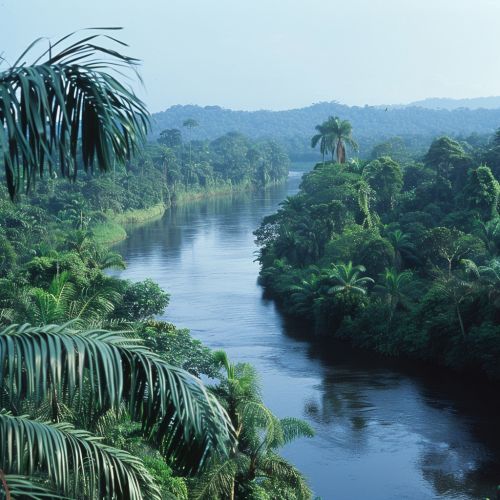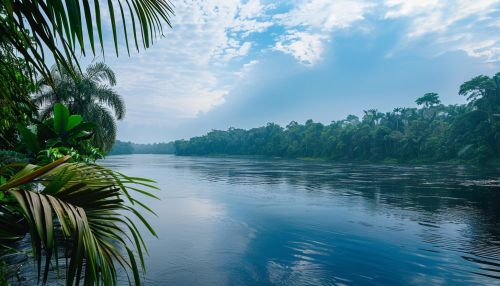Democratic Republic of Congo
Geography and Climate
The Democratic Republic of Congo (DRC) is located in Central Africa and is the second-largest country on the continent by area. It is bordered by nine countries: the Central African Republic and South Sudan to the north, Uganda, Rwanda, Burundi, and Tanzania to the east, Zambia and Angola to the south, and the Republic of the Congo to the west. The country also has a small coastline on the Atlantic Ocean.


The DRC is dominated by the Congo River Basin, which covers about 1,000,000 square kilometers. The Congo River is the second-longest river in Africa and the second-largest in the world by discharge volume. The basin is surrounded by plateaus merging into savannas in the south and southwest, by mountainous terraces in the west, and by dense tropical rainforests in the central and northern regions. The eastern border is characterized by the Albertine Rift, part of the East African Rift system, which includes several of Africa's Great Lakes.
The climate of the DRC is equatorial, with high temperatures and humidity throughout the year. The country experiences a bimodal rainfall pattern, with two rainy seasons separated by a short dry season. The northern part of the country has a tropical rainforest climate, while the southern part experiences a more savanna-like climate.
History
The history of the Democratic Republic of Congo is complex and marked by periods of colonization, conflict, and political instability. The region was originally inhabited by various ethnic groups, including the Pygmies and Bantu-speaking peoples. The Kingdom of Kongo, one of the most powerful states in Central Africa, was established in the 14th century and lasted until the 19th century.
In the late 19th century, the area became a personal possession of King Leopold II of Belgium, known as the Congo Free State. Leopold's rule was characterized by extreme exploitation and atrocities, leading to international outrage and the eventual transfer of control to the Belgian government in 1908, creating the Belgian Congo.
The DRC gained independence from Belgium on June 30, 1960, but the transition was tumultuous. The country was soon plunged into the Congo Crisis, a period of political upheaval and conflict that lasted until 1965. Mobutu Sese Seko seized power in a coup and established a one-party state, renaming the country Zaire in 1971. Mobutu's regime was marked by corruption, human rights abuses, and economic decline.
In 1997, Laurent-Désiré Kabila overthrew Mobutu, and the country was renamed the Democratic Republic of Congo. However, the DRC soon became embroiled in the Second Congo War (1998-2003), which involved multiple African nations and resulted in millions of deaths. Despite the official end of the war, the eastern regions of the country remain affected by ongoing conflict and instability.
Economy
The economy of the Democratic Republic of Congo is heavily reliant on natural resources, particularly mining. The country is rich in minerals such as cobalt, copper, diamonds, gold, and coltan, which are essential for various industries, including electronics and renewable energy. The DRC is the world's largest producer of cobalt, a critical component in lithium-ion batteries.
Agriculture is another significant sector, employing the majority of the population. Key crops include cassava, maize, rice, and plantains. However, the agricultural sector faces challenges such as poor infrastructure, limited access to markets, and ongoing conflict in certain regions.
The DRC's economic potential is hindered by political instability, corruption, and inadequate infrastructure. The country ranks low on the Human Development Index and faces significant challenges in terms of poverty, health, and education. Efforts to improve governance, attract foreign investment, and rebuild infrastructure are crucial for the country's economic development.
Demographics
The Democratic Republic of Congo has a diverse population, with over 200 ethnic groups. The largest ethnic groups include the Luba, Kongo, and Mongo. The official language is French, but there are four national languages: Lingala, Swahili, Kikongo, and Tshiluba. These languages are widely spoken and serve as lingua francas in different regions of the country.
The population of the DRC is predominantly rural, with only about 40% living in urban areas. Kinshasa, the capital and largest city, is home to over 11 million people and is one of the largest cities in Africa. Other major cities include Lubumbashi, Mbuji-Mayi, and Kisangani.
The DRC has one of the highest fertility rates in the world, with an average of six children per woman. This contributes to a rapidly growing population, which is expected to double by 2050. The country also has a young population, with a median age of around 17 years.
Culture
The culture of the Democratic Republic of Congo is rich and diverse, reflecting the country's ethnic and linguistic diversity. Traditional music and dance play a central role in Congolese culture. The DRC is known for its vibrant music scene, particularly genres such as soukous (also known as Congolese rumba) and ndombolo. Prominent musicians from the DRC include Franco Luambo, Papa Wemba, and Koffi Olomide.
Art and craftsmanship are also important aspects of Congolese culture. The country is known for its intricate masks, sculptures, and textiles, which often have spiritual and ceremonial significance. Traditional crafts are produced by various ethnic groups and are an important part of cultural heritage.
The DRC has a rich oral tradition, with storytelling, proverbs, and folklore playing a significant role in preserving history and cultural values. Literature in the DRC has also flourished, with notable authors such as Sony Labou Tansi and Alain Mabanckou gaining international recognition.
Politics and Government
The Democratic Republic of Congo is a semi-presidential republic, with a president serving as the head of state and a prime minister as the head of government. The political system is based on the constitution adopted in 2006, which established a framework for democratic governance and the separation of powers.
The president is elected by popular vote for a five-year term and can serve a maximum of two terms. The prime minister is appointed by the president and must be approved by the National Assembly. The bicameral parliament consists of the National Assembly and the Senate, which are responsible for legislative functions.
The DRC has experienced significant political instability and conflict since gaining independence. The country has faced challenges such as corruption, weak institutions, and human rights abuses. Efforts to promote political stability and democratic governance are ongoing, with support from international organizations and civil society.
Health and Education
The health and education sectors in the Democratic Republic of Congo face numerous challenges. The country has some of the lowest health indicators in the world, with high rates of maternal and child mortality, malnutrition, and infectious diseases such as malaria, tuberculosis, and HIV/AIDS. Access to healthcare is limited, particularly in rural areas, and the healthcare system is under-resourced and understaffed.
Education in the DRC is also facing significant challenges. The country has one of the lowest literacy rates in the world, with significant disparities between urban and rural areas, and between boys and girls. Primary education is officially free and compulsory, but many children do not attend school due to factors such as poverty, conflict, and lack of infrastructure.
Efforts to improve health and education in the DRC are ongoing, with support from international organizations, non-governmental organizations, and the government. Initiatives include improving access to healthcare, increasing funding for education, and promoting gender equality in education.
Natural Resources and Environmental Issues
The Democratic Republic of Congo is one of the most resource-rich countries in the world, with vast deposits of minerals, forests, and water resources. The country is home to the second-largest rainforest in the world, which plays a crucial role in global biodiversity and climate regulation. The DRC's forests are home to a wide variety of plant and animal species, including endangered species such as the mountain gorilla and the okapi.
However, the exploitation of natural resources in the DRC has led to significant environmental issues. Deforestation, driven by logging, agriculture, and mining, is a major concern. The loss of forest cover has negative impacts on biodiversity, climate change, and the livelihoods of local communities. Illegal mining and the extraction of minerals have also led to environmental degradation, including soil erosion, water pollution, and habitat destruction.
Efforts to address environmental issues in the DRC include initiatives to promote sustainable forest management, combat illegal logging and mining, and protect biodiversity. International organizations, non-governmental organizations, and the government are working together to implement conservation programs and raise awareness about the importance of environmental protection.
Infrastructure and Transportation
Infrastructure and transportation in the Democratic Republic of Congo are underdeveloped and face significant challenges. The country's vast size and difficult terrain, combined with years of conflict and neglect, have resulted in poor infrastructure and limited connectivity.
The road network in the DRC is inadequate, with many roads in poor condition or impassable during the rainy season. The country has a limited number of paved roads, and many areas are accessible only by dirt tracks. The lack of reliable road infrastructure hampers economic development and access to essential services.
The DRC has a limited railway network, with the main lines connecting the mining regions in the south to the port of Matadi on the Atlantic coast. The railways are in need of rehabilitation and modernization to improve efficiency and safety.
The Congo River and its tributaries are important transportation routes, particularly for the movement of goods and people in the central and northern regions of the country. However, river transport is also hindered by inadequate infrastructure and maintenance.
Air transport is crucial for connecting remote and inaccessible areas of the DRC. The country has several international airports, including N'djili Airport in Kinshasa and Lubumbashi International Airport. However, the aviation sector faces challenges such as outdated infrastructure, safety concerns, and limited connectivity.
Efforts to improve infrastructure and transportation in the DRC are ongoing, with support from international organizations and development partners. Investments in road, rail, and air transport are essential for promoting economic growth and improving access to services.
